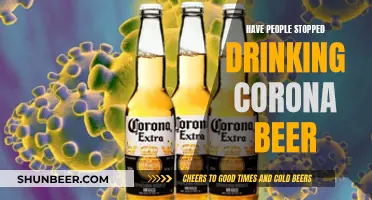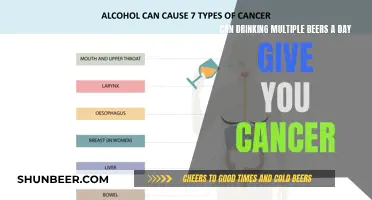
The consumption of super-strength lager and cider among homeless people has been a cause for concern for charities and health professionals. These drinks, which are cheap and have high alcohol content, are easily accessible to homeless people and can contain the same amount of alcohol as 22 shots of vodka. Charities like Thames Reach have called for restrictions on the sale of these drinks, citing the devastating impact they have on the health of homeless people.
What You'll Learn

The dangers of super-strength lager and cider
Super-strength lager and cider are cheap, high-alcohol content drinks that are contributing to the deaths of homeless people across the UK. The drinks are often sold for less than £1 per can, making them affordable for people with alcohol dependency and little money. The drinks are not available in pubs or bars or in more affluent areas but can be found in small off-licences in less wealthy areas.
The drinks have been nicknamed "tramp juice" and are often consumed by homeless people to excess. The high alcohol content, combined with the low price, makes them a dangerous and deadly combination. The average age of death for those consuming these drinks is 52, with many experiencing health issues such as liver failure, organic brain damage, dementia, mobility issues, and double incontinence.
In the UK, a three-litre bottle of high-strength (7.5%) white cider can cost as little as £3.50 and contains the same amount of alcohol as 22 shots of vodka. This cheap availability is causing a rise in alcohol-related deaths among the homeless population, with charities calling for restrictions and increased taxes on the sale of these drinks.
One such charity, Thames Reach, has been lobbying the government and the drinks industry to ban the sale of super-strength lagers and ciders, citing that five out of six deaths at their hostels are directly linked to the consumption of these drinks. They argue that the low pricing deliberately targets individuals with alcohol dependency and limited financial means.
The drinks industry, however, argues that these drinks have a legitimate market and are also consumed by responsible adult drinkers. They claim that increasing taxes or banning the sale of these drinks will not solve the problem, as those with alcohol dependency will simply switch to other cheap alternatives.
Despite the debate, the fact remains that super-strength lager and cider are causing significant harm to the homeless community, with many individuals struggling to access treatment for their addiction. The high alcohol content and easy availability of these drinks create a cycle of dependency and health issues that can lead to premature death.
Texas Teen Beer Laws: What's Allowed?
You may want to see also

The impact of cheap alcohol on the homeless community
Cheap, strong alcohol is a major problem for the homeless community. In London, 44% of rough sleepers have an alcohol problem, and many consume super-strength drinks. These drinks are often sold for less than £1.50 per can, and are often cheaper than weaker alternatives. This makes them very accessible to people with alcohol dependency issues and little money.
The consumption of these drinks has severe health consequences for the homeless community. Charities report that excessive consumption is causing clients to develop problems usually associated with older people, including liver failure, organic brain damage, dementia, mobility issues, and double incontinence. There is also a heightened risk of death. One charity reported that 10 out of 16 deaths in their hostels over the past year were directly attributable to super-strength drinks.
The consumption of cheap, strong alcohol also has a negative impact on the mental health of the homeless community. Alcohol is often used as a coping mechanism for dealing with harsh living conditions and painful memories. However, this can lead to further issues, such as depression and psychotic and mood disorders. Alcohol dependence can also act as a barrier to health and social services, making it harder for homeless people to access the support they need.
The consumption of cheap alcohol is also linked to an increased risk of unprotected sex and the contraction of HIV and other sexually transmitted diseases. This is due to alcohol's disinhibiting effect, which can lead to riskier behaviour.
In addition to the health consequences, the consumption of cheap alcohol can also lead to social and economic problems for the homeless community. It can make it harder for people to hold down jobs or maintain stable housing, leading to a cycle of poverty and homelessness.
To address the impact of cheap alcohol on the homeless community, a range of interventions and treatments have been proposed. These include:
- Increasing tax on strong lagers and other super-strength drinks to make them less affordable and accessible.
- Banning the sale of super-strength drinks.
- Providing more support for homeless people with alcohol addiction, including detox programmes and harm reduction strategies.
- Creating stable housing and employment opportunities to help people move away from alcohol dependence.
- Educating people about the dangers of cheap alcohol and promoting healthier alternatives.
Overall, the consumption of cheap alcohol has a significant negative impact on the homeless community, affecting their physical and mental health, social and economic situation, and access to services. Addressing this issue requires a multi-faceted approach that targets both the availability of cheap alcohol and the underlying causes and consequences of alcohol dependence in the homeless community.
The Chemistry of Beer: How It Works and Why It Matters
You may want to see also

The role of shops in selling super-strength drinks to the homeless
Shops selling super-strength drinks to the homeless have been a matter of concern for various charities and organisations. The homeless charity Thames Reach claims that five out of six deaths at their hostels are a direct result of drinking super-strength lager or cider, which is often referred to as "tramp juice". The charity has been lobbying the government and the drinks industry to ban the sale of such drinks. They argue that these drinks are deliberately priced low to target individuals with alcohol dependency and limited funds.
Peter Mansfield-Clark, who runs the Three Bridges homeless hostel Crawley Open House, has also called out shops for selling super-strength drinks to the homeless. He believes that shops should act more responsibly and stop selling these drinks to the homeless, as they are incredibly cheap and lethal. He suggests raising prices so that homeless people cannot buy large quantities with their limited money.
In response to the concerns raised by Thames Reach, the drinks industry's regulatory body, the Portman Group, stated that these drinks have a legitimate market among responsible adult drinkers. The Group's Chief Executive, David Poley, acknowledged that while people with alcohol dependency problems also consume these drinks, it does not necessarily indicate irresponsible selling. He further emphasised that there is a need to distinguish between the drink and the consumer, and that the focus should be on addressing problem drinkers rather than the drink itself.
Some shops have taken steps to address the issue by no longer stocking super-strength drinks. This change has been driven by public disorder concerns, as the excessive consumption of these drinks has led to an increase in unconscious homeless people on the streets. However, homeless people are now travelling further to purchase these drinks from shops that still sell them.
While the sale of super-strength drinks to the homeless remains a complex issue, there are calls for a multi-faceted approach to address it. This includes increasing prices, restricting sales, and providing support for those struggling with alcohol addiction.
Non-Alcoholic Beer: Healthy Choice, Full Flavor
You may want to see also

The effectiveness of increasing prices to reduce consumption
The relationship between the price of alcohol and the consumption of alcohol has been a topic of interest for many years, with some arguing that raising the price of alcohol is an effective way to reduce harmful drinking. This is particularly relevant when considering the issue of alcohol consumption among the homeless population, where cheap, super-strength alcohol has been linked to devastating health consequences and even deaths.
In the UK, there have been calls from homeless charities, such as Thames Reach, to increase the price of super-strength lagers and ciders, which are often sold at very low prices. These drinks can have alcohol content exceeding 7.5% and are easily accessible in small off-licenses in less affluent areas. The cheap and strong nature of these drinks makes them particularly appealing to individuals with alcohol dependency issues and limited financial resources, including the homeless.
Secondly, empirical evidence has shown a positive correlation between the price of alcohol and public health outcomes. For example, a study in Australia between 1990 and 2000 demonstrated that adjusting alcohol prices resulted in a reduction in overall alcohol consumption. This provides support for the notion that increasing the price of super-strength alcohol could lead to decreased consumption among the homeless, potentially improving their health and reducing alcohol-related deaths.
Additionally, the World Health Organization (WHO) claims that "a large body of literature has found raising the price of alcohol to be effective in reducing harmful use of alcohol among drinkers". This statement adds further weight to the argument that increasing prices can be an effective strategy to reduce alcohol consumption, particularly harmful drinking.
However, it is important to acknowledge that the relationship between price and consumption is not absolute, and there are other factors at play. For instance, some individuals may be more price-insensitive, especially those with severe alcohol dependency. In such cases, they may be willing to sacrifice other expenses to continue purchasing alcohol, even at increased prices. Additionally, the availability and accessibility of alternative substances or cheaper sources of alcohol could impact the effectiveness of price increases as a reduction strategy.
In conclusion, increasing the price of super-strength alcohol is likely to be an effective strategy to reduce its consumption among the homeless population, particularly for those with limited financial resources. However, it is essential to recognize that the effectiveness of this strategy may vary depending on individual circumstances and the availability of alternative substances. A multi-faceted approach, including treatment for alcohol addiction and improved access to support services, may be necessary to comprehensively address the issue of alcohol consumption among the homeless.
Kicking the Beer Habit: Strategies for Sobriety
You may want to see also

The challenges of treating alcohol addiction among the homeless
Treating alcohol addiction among the homeless population comes with a unique set of challenges. The stressors of living on the streets, coupled with mental health issues and a lack of access to resources, create a complex dynamic that requires specialized approaches to effectively address addiction. Here are some of the key challenges:
Trust and Engagement:
Homeless individuals often struggle to trust others and form relationships, which can make it difficult for them to engage with treatment services. They may have experienced trauma or have had negative interactions with authorities, leading to a sense of wariness and reluctance to seek help. This distrust can be a significant barrier to accessing the necessary support for recovery.
Housing Instability:
Stable housing is a crucial factor in the recovery process. However, for the homeless, finding and maintaining stable housing can be incredibly challenging. Without a fixed address, individuals may not have a consistent place to receive treatment or a safe and sober living environment to support their recovery. This instability can hinder progress and increase the risk of relapse.
Mental Health Comorbidities:
Mental health disorders are prevalent among the homeless population, with many individuals suffering from conditions such as PTSD, depression, and anxiety. These disorders often co-occur with substance use disorders, creating a complex dynamic known as dual diagnosis. Treating both conditions simultaneously can be challenging, and the lack of access to consistent mental health services can further complicate the recovery process.
Self-Medication:
The stressors of living on the streets, coupled with mental health issues, can drive homeless individuals to self-medicate with alcohol. They may use alcohol to cope with traumatic experiences, emotional distress, or the harsh realities of their living situation. This self-medication can lead to a cycle of dependency, making it challenging to break free from addiction.
Access to Affordable Treatment:
Homeless individuals often face barriers in accessing affordable and effective treatment options. They may not have the financial means to pay for private treatment or transportation to and from treatment facilities. Additionally, the stigma associated with homelessness and addiction can further hinder their ability to seek and engage with necessary support services.
Peer Pressure and Social Influences:
The social environment in which homeless individuals find themselves can influence their drinking habits. Peer pressure and the normalization of heavy drinking within certain homeless communities can make it difficult for individuals to reduce their alcohol consumption. Social connections formed around alcohol can also contribute to a sense of belonging and community, making it challenging for individuals to detach themselves from these influences.
Addressing the Challenges:
To effectively address these challenges, a comprehensive and holistic approach is necessary. This includes providing stable housing or residential treatment programs, offering integrated mental health and addiction services, and building trust through compassionate and non-judgmental care. By addressing the multifaceted needs of this vulnerable population, we can improve their chances of achieving long-term recovery and rebuilding their lives.
Is Day-Old Beer Safe to Drink?
You may want to see also







